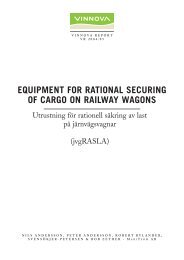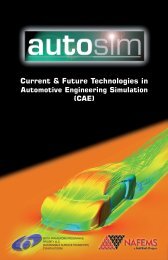WP3: Rail Passenger Transport - TOSCA Project
WP3: Rail Passenger Transport - TOSCA Project
WP3: Rail Passenger Transport - TOSCA Project
You also want an ePaper? Increase the reach of your titles
YUMPU automatically turns print PDFs into web optimized ePapers that Google loves.
PJ. Low-GHG electric power<br />
Electric power is by 2009 produced by a number of means in Europe, some of them using<br />
fossil fuels (mainly coal and natural gas), some of them with renewable energy (hydro, with<br />
increasing shares of wind and biomass). Nuclear power is also an essential source of nonrenewable<br />
energy, but with zero direct GHG emissions. Fossil fuels had by 2007 about 50 %<br />
share of the total. The electric power production is part of the European Trading Scheme<br />
(ETS), which means that GHG emissions will have a monetary price. Tomorrow’s electric<br />
power mix must have substantially diminishing dependence of fossil fuels if GHG emission<br />
targets are to be met. Further, long-term technology options include carbon capture and storage<br />
(CCS) as well as geothermal energy, and possibly also solar and sea wave power. Also, an<br />
increasing share of combined heat and electric power (CHP) production (with fossil or bio<br />
fuels) increases the efficiency and reduces specific emissions related to electric power.<br />
The GHG emissions from today’s electric power mix are estimated in <strong>TOSCA</strong> WP4 as being<br />
460 gCO 2 -eq per kWh of electricity at consumer's outlet. GHG emissions from future<br />
European electric power is a scenario variable in stage 2 and will be determined by WP6 in cooperation<br />
with other work packages.<br />
Substantially reduced average GHG emissions from electric power production will be a very<br />
effective means of reducing emissions from the European transport sector, not only for<br />
railways but possibly also for passenger cars in the road sector. For example, a reduction of<br />
GHG content per kWh of electricity by 80 % will reduce specific emissions of electric trains<br />
by the same amount. Maximum market penetration in the rail sector is about 90 % (i.e. current<br />
and future diesel operation is excluded).<br />
PK. Magnetic levitation (Maglev)<br />
Magnetic levitation has been technically developed for commercial introduction since about<br />
2000, both in Germany and Japan. However, only one commercial magnetic railway for higher<br />
speeds has been built, i.e. the Shanghai airport Maglev system. In addition, a long-distance line<br />
of 200 km is reported to be planned outside Shanghai. Magnetic levitation trains achieve<br />
commercial top speeds in the range of 400 to 500 km/h; the horizontal curves may be tighter<br />
and the gradients steeper than on conventional railways for the same design speed. Despite<br />
these advantages, the cost of constructing magnetic railways is high, partly due to the<br />
installation of continuous high-powered linear drives and levitation equipment along the line.<br />
Another drawback is the non-existing interoperability with conventional railway systems. In<br />
addition, the difference in average speed between Maglev and conventional high-speed rail<br />
has been successively reduced in comparison with the situation 40 years ago, when the<br />
development of magnetic levitation started.<br />
Energy consumption is estimated to be in the same order as on conventional high-speed stateof-the-art<br />
trains at the same speed (Kemp et al, 2007). Other sources end up with almost the<br />
same conclusion, or somewhat higher energy consumption for magnetic rail, all comparing the<br />
same speed. However, if the full speed potential of magnetic levitation is to be achieved the<br />
total energy demand will increase. This is in spite of the fact that the above-mentioned<br />
technology options PA, PB, and PD (see above) are already included in existing proposals for<br />
magnetic levitation systems.<br />
The option of Maglev trains will not be further studied in the context of Tosca, as this option is<br />
not suited for reduction of energy consumption and GHG emissions.<br />
Deliverable D4 – <strong>WP3</strong> passenger 11
















